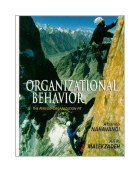(Special Offer: Discount 50% of the price)
Afsaneh Nahavandi ,
Arizona State University West
Ali R. Malekzadeh , St. Cloud State University
Published November 1998 by
Prentice Hall Business Publishing
Copyright 1999, 609 pp.
Cloth ISBN 0-13-285982-3
Unique in approach, this text
smoothly intertwines cross-cultural issues into each chapter to give students the
skills they need to manage in today's global environment. It helps students understand the
"big picture" of organizational behavior by providing an overview of select
macro topics early in the text, and then integrating them throughout. Includes an
integrative, end-of-part video case on Jagged Edge Mountain Gear.
Extensive Web Support-With
PHLIP and Companion Website '99. The site is found at www.prenhall.com/nahavandi
Instructor support-Includes
updated articles that are referenced to the text; downloadable PowerPoint and Instructor's
Manual files; an On-Line Syllabus Builder; sample syllabi; links to related sites; and
more.
Student support-Includes
updated articles; an interactive study guide graded by our server that provides immediate
feedback and allows students to e-mail their scores to instructors; Web-based exercises;
links to other sites for researching topics in the text; and more.
Integration of Managing
Change-Introduces the concepts of change and their effects on OB (Ch. 1); provides
"Change Challenge" features (in half the chapters) that spotlight current OB practices
on managing change; and devotes a full chapter to Organizational Change (Ch. 14).
A focus on Teams-Introduces
the use of teams in organizations in Ch. 1; features "Team Challenges" in half the
chapters; provides cutting-edge coverage of groups and teams (Chs. 7 and 8).
The effects of Technology
on OB-Introduces the effects of technology on OB in Ch. 2; revisits technology
issues in many chapters, including decision making, communication, and teams.
A focus on Multiple
Stakeholders-Introduces the concept of multiple stakeholders in Ch. 1; revisits the
social responsibility issues in two Question of Ethics features in each chapter.
Balance of Large
Corporations and Small Businesses-Offers examples from both types of organizations.
A focus on the Fit between
the Individual (Person) and the Organization-Features a unique last chapter on the
person-organization fit.
Shows students how their
personal effectiveness affects and is affected by the organization's effectiveness.
I. THE CONTEXT.
1. The Challenge of
Managing People and Organizations.
2. Understanding the Context of Organizations.
3. Culture in Organizations.
II. UNDERSTANDING THE
INDIVIDUAL.
4. Understanding and
Managing Individual Differences.
5. Understanding People: Social Perception.
6. Managing Performance through Motivation and Outcomes.
III. UNDERSTANDING TEAMS.
7. The Building Blocks of
Group Behavior.
8. Turning Groups into Teams.
9. Leading People.
V. ORGANIZATIONAL
PROCESSES.
10. Making Decisions.
11. Using Power and Organizational Politics.
12. Communicating Effectively.
13. Managing Conflict and Negotiating.
14. Managing Change.
IV. THE
PERSON-ORGANIZATION FIT.
15. Effectiveness: The
Person-Organization Fit.
APPENDICES.
I. The History of
Management Ideas.
II. Research Methods in Organizational Behavior.
III. Scoring Keys.
Glossary.
Index.
Księgarnia nie działa. Nie odpowiadamy na pytania i nie realizujemy zamówien. Do odwolania !.


